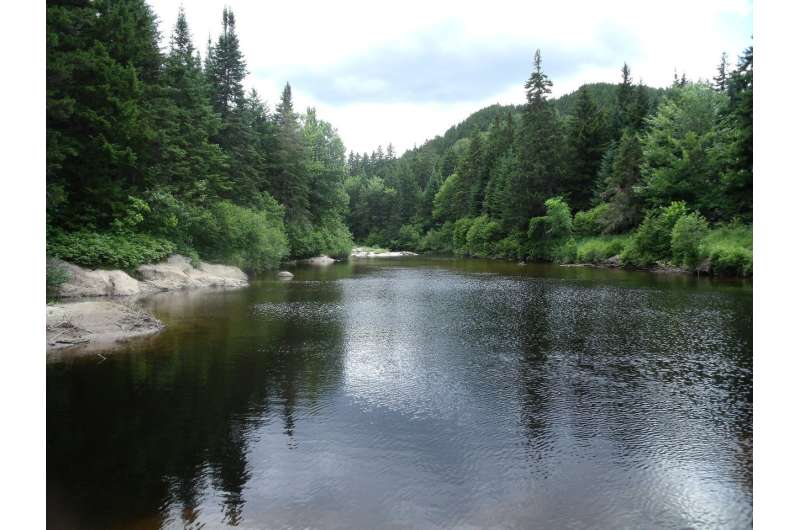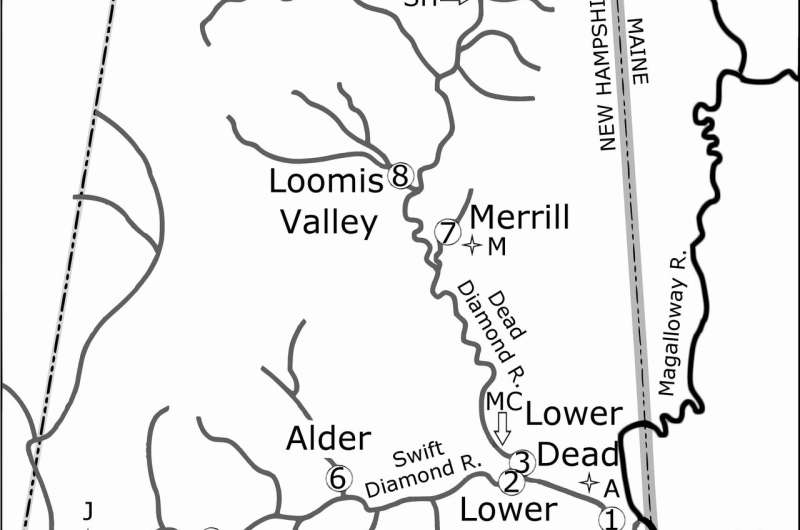Stream from Dartmouth's Second College Grant in the Dead Diamond River Watershed. Credit: Lauren Culler
Air temperature increases from climate change will make New Hampshire's streams warmer, according to Dartmouth-led research published in Freshwater Biology.
The study examined the extent to which stream waters are warming, which has implications for freshwater ecosystems across the nation given that many species depend on cold water to survive.
"Understanding how climate change is affecting our streams can help us identify which watershed areas should be of conservation or management priority, particularly areas that act as cold water refuges for brook trout and aquatic invertebrates," said Lauren Culler, the lead author and a research assistant professor of environmental studies.
Previous studies show that stream temperatures react to changes in air temperature and that this can affect the distribution, abundance, physiology, behavior and mortality of cold water fish and other species such as mayflies and stoneflies, invertebrates that support species such as brook trout. Yet, long-term monitoring of stream temperatures has typically been inadequate. Furthermore, most locations with long-term data are in highly managed or urban areas, which affect the natural relationship between air and water temperatures.
Figure 1 from the study and the map of streams in the Dead Diamond River Watershed (grey lines). Credit: Map by Lauren Culler was created using ArcMap 10.3.1.
The research team analyzed 11 years of air temperatures and stream temperatures (2001 to 2011) in Dartmouth's Second College Grant, 27,000 acres of boreal forest in the Dead Diamond River Watershed, the largest uninhabited watershed in New Hampshire and Vermont. The watershed is home to the only native population of brook trout in the two states and is also in the fastest warming region in the contiguous U.S. The researchers examined how diurnal and daily air temperature changes corresponded with water temperature changes, and then built a model predicting maximum stream temperature as a function of air temperature.
The study found that changes in air temperature were a prominent driver of changes in water temperature from June through September but that the streams varied in their sensitivity. For every 1-degree Celsius or 1.8 Fahrenheit increase in air temperature, the maximum daily water temperature increased by 0.5 to 0.8 Celsius or 0.9 to 1.2 Fahrenheit. Although streams appeared to be buffered to some extent from increases in air temperature, the researchers expect that future warming will bring about stressful thermal conditions for cold-water loving species such as brook trout. "Once temperatures reach about 20 Celsius (68 Fahrenheit), we know that many stream organisms start to experience adverse effects," explained Culler.
Stakeholders can use the model developed for the study, to help identify watersheds of priority and inform policy. Such protections may include conserving headwater lands, which affect downstream habitats that according to the study, "are colder and less sensitive to changes in air temperature." The researcher team calls on stream temperatures to be monitored, to help ensure the future of our freshwater ecosystems.
More information: Lauren E. Culler et al. Streams in an uninhabited watershed have predictably different thermal sensitivities to variable summer air temperatures, Freshwater Biology (2018). DOI: 10.1111/fwb.13105
Provided by Dartmouth College
























